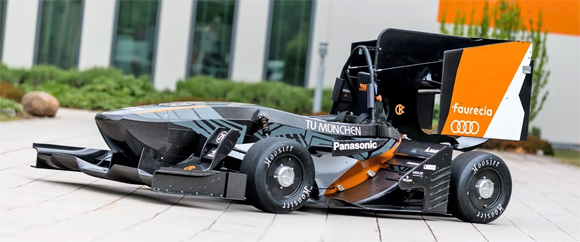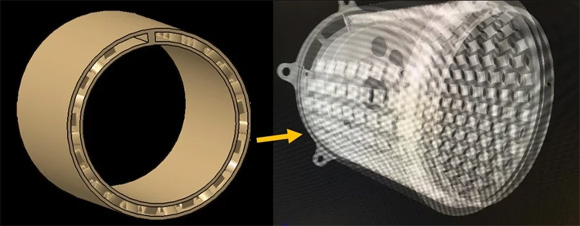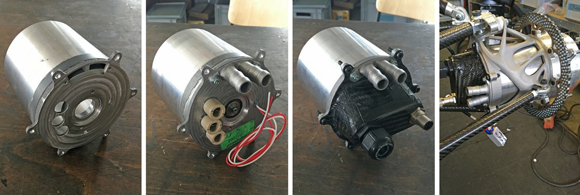TU Munich’s student racing team uses GKN’s metal AM to boost vehicle performance
June 8, 2018

Team TUfast’s Formula Student / Formula SAE racing vehicle (Courtesy GKN Sinter Metals Blog)
Students from Team TUfast, the Formula Student racing team at the Technical University of Munich (TU Munich), Germany, have partnered with GKN Powder Metallurgy’s Additive Manufacturing business to produce a metal AM motor housing for its electric race car.
The annual Formula SAE and Formula Student competitions challenge students to build electric race cars, which compete and are ranked based on their design, acceleration, electrical efficiency, endurance, cost and manufacturing analysis. This year’s Formula Student will comprise of three races, beginning July 15 at Silverstone, UK, and continuing at Hockenheim, Germany and Barcelona, Spain.
In previous year’s, Team TUfast’s vehicle has been powered by a small, power-dense motor forced into the wheel hub. This operated at very high temperatures, damaging the motor, the team’s race performance and the endurance points earned.
By using metal AM, the team was able to produce a metal housing small enough to fit precisely into the wheel hub, while incorporating a system of cooling channels to enhance the vehicle’s performance. The TUfast racing team also topographically-optimised its parts, reducing the wheel-packaged weight by around 0.6 kg.
In a post on The GKN Sinter Metals Blog, GKN Powder Metallurgy’s Dr Simon Höges, Manager Additive Manufacturing, spoke to Team TUfast’s Marco Tönjes, responsible for the development of the electric motor and its components, about the decision to move to AM.
“The electric motor is typically not part of the chassis, but here it is because it has a wheel hub drive,” stated Tönjes. “And since it has a wheel hub drive, it has many interfaces to the chassis. I’m in charge of the design and construction of the components that comprise the electric motor. Several of the other teams that we compete against buy their motors. We prefer to build ours.”
“The all-wheel drive wheel hub of this year’s vehicle combines the different drive components, and its functions are integrated in a compact and lightweight-optimised design for the lowest amount of space. Next to the topology optimised upright, the gearbox and the braking system is the electric motor. The laser sintered aluminum body with the new integrated cooling structure is the centerpiece of the powertrain.”

The new cooling structure has integrated cooling channels (Courtesy TUfast Racing Team)
According to Tönjes, this year’s cooling system is fundamentally different from that used in 2017’s motor, which did not perform as desired. In 2018, the team integrated a cooling structure which encloses the motor like a jacket, and is fluid-dynamically optimised to maximise heat transfer; essential to enable the electric motor to deliver a constant, high level of power.
“The structure consists of an inner cooling channel with a special optimised pin structure. The cooling channel is directly integrated in the housing, in which the stator is cast,” stated Tönjes. “The manufacturing of this structure with its closed jacket structure is not realisable with conventional methods. Additive Manufacturing, or more precisely, laser sintering, is the only process that makes it possible to manufacture this component.”
The new cooling geometry is said to have increased heat conduction by 2%, with the same mass flow, compared to the previous structure, while the decreased pressure drop across the entire cooling system of the four-wheel-driven electric vehicle is said to have increased total mass flow by 31%. The result is a total heat conduction and efficiency increase of almost 20%.

Step-by-step assembly of the wheel-hub-drive (Courtesy TUfast Racing Team)
With the help of GKN Powder Metallurgy, the team was able to further optimise the housing. “We originally wanted to implement the adapter for the cooling connections as an integral part with the housing. However, GKN’s engineers had a different approach,” explained Tönjes. “They suggested that we should separate the housing and connection adapter, as this significantly reduces the support structures required for production. The adapter, which is also laser-sintered by the additive business of GKN Powder Metallurgy, is now screwed to the housing with two screws.”
Tönjes added that the team hopes to make further use of metal AM components in the next season, stating, “Compared to the normal automotive sector, metal 3D printing is particularly versatile in racing. Especially for small quantities, it is a fascinating technology. You can do everything without needing a mold or a tool.”
















